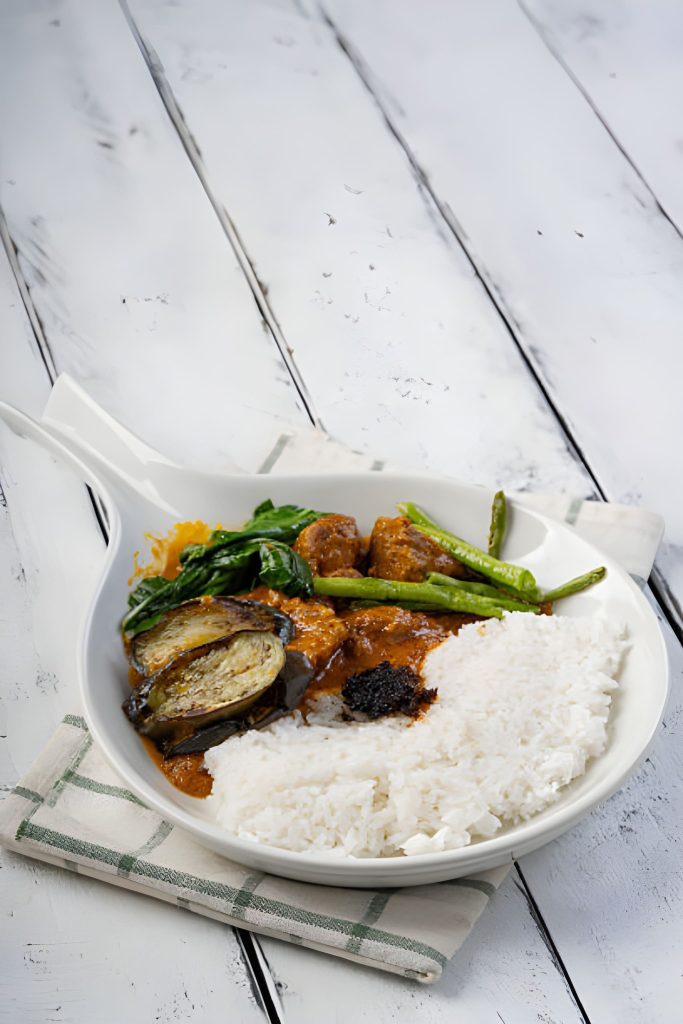Kare Kare Recipe
Rich, nutty, and comforting, Kare Kare is a quintessential Filipino stew that captures the warmth of home-cooked meals and festive gatherings. With its creamy peanut sauce, tender beef, and colorful mix of vegetables, this dish is a symphony of texture and flavor. The deep orange hue from annatto water adds visual appeal, while every spoonful brings together savory, earthy, and subtly sweet notes — perfectly balanced when paired with a serving of shrimp paste and rice.

Ingredient Breakdown
Each component of Kare Kare contributes to its remarkable depth and balance. The beef, simmered until fork-tender, brings richness and substance, absorbing the luscious peanut sauce with every bite. The sauce itself is what defines this dish — a silky blend of peanut butter and freshly ground roasted peanuts thickened with rice flour for a smooth, velvety consistency. Annatto water gives the stew its iconic amber tone, adding warmth both in color and aroma.
The selection of vegetables provides contrast and freshness. Banana blossom lends an earthy, slightly floral undertone, while eggplant and string beans contribute texture and a mild sweetness that balances the richness of the sauce. Bok choy adds a fresh, leafy note, completing the ensemble. Together, these ingredients create harmony — a balance of creamy, savory, and vegetal flavors that make Kare Kare deeply satisfying.
Step-by-Step Preparation Guide
The foundation of Kare Kare starts with building the aroma. Heating vegetable oil in a deep pot, the garlic and onions are sautéed until they release their fragrance, setting the stage for the beef to soak in their savory essence. Once the beef cubes are added, they’re browned lightly, locking in their juices and enhancing their flavor.
Next comes the infusion of color and depth. The annatto water — a natural coloring made by soaking atsuete seeds — is poured in, followed by water and peanut butter. The combination creates a rich, nutty base that begins to simmer into a smooth broth. The vegetables are then layered in, starting with banana blossom, eggplant, and string beans. These simmer gently until tender, absorbing the sauce’s peanut aroma before being set aside to maintain their texture.
As the sauce thickens, the ground roasted peanuts and rice flour are added, giving it a creamy, indulgent consistency. The beef continues to cook slowly in the sauce until tender enough to fall apart with a fork. Finally, the vegetables are returned to the pot along with fresh bok choy, which wilts just slightly in the residual heat. The result is a thick, aromatic stew — golden in color, hearty in flavor, and rich in tradition.

Recipe Tips & Frequently Asked Questions
Use a combination of peanut butter and freshly ground peanuts for authentic flavor and creaminess.
This balance provides both smooth texture and roasted nuttiness.
Toast the rice flour lightly before adding it to enhance the nutty aroma of the sauce.
It deepens the flavor and prevents a raw flour taste.
Strain the annatto water properly to achieve a smooth, even color.
Unstrained seeds can create uneven streaks or bitterness.
Avoid overcooking the vegetables to keep their color vibrant and texture firm.
They should be tender yet retain a bit of bite.
For extra flavor, simmer the beef longer for a melt-in-the-mouth tenderness.
The longer it cooks, the richer the sauce becomes.
Can I use other types of meat?
Yes, oxtail, tripe, or pork hock are traditional options and lend a deeper flavor to the dish.
What can I substitute for annatto seeds?
Annatto powder or paprika can be used, though the flavor will be slightly different.
Can I make it vegetarian?
Replace the beef with tofu or mushrooms and use vegetable broth for a lighter, plant-based version.
Why is my sauce too thick?
Add water or broth gradually while stirring until the desired consistency is achieved.
Can it be made ahead?
Yes, Kare Kare often tastes even better the next day, as the flavors continue to deepen overnight.
What to Serve With This Recipe
Kare Kare is traditionally paired with steamed jasmine rice, which perfectly complements its rich sauce. For a touch of contrast, serve it with bagoong alamang (fermented shrimp paste) — its salty, slightly sweet flavor balances the peanut sauce beautifully. Grilled eggplant or sautéed greens also pair well, adding freshness to the meal. For drinks, a glass of iced tea or calamansi juice provides a crisp, citrusy balance that cuts through the dish’s richness.
Creative Variations
Kare Kare’s versatility allows for delicious creativity. A splash of coconut milk can add a silky, tropical twist, making the sauce even creamier. Chicken or seafood can be used instead of beef for a lighter, coastal-inspired version. Those who enjoy a touch of heat can add chili flakes or serve it with spicy bagoong for extra kick. For a modern fusion twist, blending roasted peanuts with sesame oil introduces an aromatic nuttiness that deepens the flavor profile.
Kare Kare is more than just a stew — it’s a celebration of Filipino comfort and culinary tradition. Its velvety peanut sauce, tender beef, and medley of vibrant vegetables come together to create a dish that is both hearty and elegant. Whether enjoyed during a festive family gathering or a quiet Sunday lunch, Kare Kare brings warmth, satisfaction, and a sense of togetherness with every spoonful.

Ingredients
½ kilo beef cubes
1 tablespoon vegetable oil
1 small red onion, finely chopped
1 tablespoon garlic, minced
2 cups water
¼ cup atsuete (annatto) seeds, soaked in 1 cup water
¼ cup peanut butter
½ cup roasted peanuts, ground into a paste
¼ cup rice flour
1 small puso ng saging (banana blossom), sliced
1 piece talong (eggplant), sliced
1 bundle sitaw (string beans), cut into 2-inch pieces
1 bundle bok choy (pechay) leaves
Salt, to taste
Ground black pepper, to taste
Instructions
Heat vegetable oil in a large heavy-bottomed pot over medium heat. Add the minced garlic and chopped onions, sautéing until fragrant and translucent.
Add the beef cubes to the pot and cook, stirring occasionally, until they start to brown slightly on the edges. Strain the annatto seeds from their soaking water and discard the seeds. Pour the vibrant red annatto water into the pot, followed by two cups of water and the peanut butter. Stir well to combine, ensuring the peanut butter dissolves into the broth.
Add the sliced puso ng saging (banana blossom), talong (eggplant), and sitaw (string beans). Simmer gently for about 30 minutes, or until the vegetables are tender but not overcooked. Carefully remove the vegetables with a slotted spoon and set them aside.
Stir in the ground peanuts and rice flour, which will help thicken the sauce and give it a rich, nutty flavor. Continue simmering the mixture, stirring occasionally, until it develops a smooth and creamy consistency.
Let the beef cook further until it becomes fork-tender and fully absorbs the flavors of the peanut sauce. Once the beef is tender, return the cooked vegetables to the pot and add the bok choy leaves. Simmer for a few minutes until the greens are wilted and the vegetables are heated through.
Season the Kare Kare with salt and ground pepper to taste. Serve warm with steamed rice and, if desired, a side of bagoong alamang (shrimp paste) for a traditional, savory-sweet contrast.

Kare Kare Recipe
Ingredients
- ½ kilo beef cubes
- 1 tablespoon vegetable oil
- 1 small red onion finely chopped
- 1 tablespoon garlic minced
- 2 cups water
- ¼ cup atsuete annatto seeds, soaked in 1 cup water
- ¼ cup peanut butter
- ½ cup roasted peanuts ground into a paste
- ¼ cup rice flour
- 1 small puso ng saging banana blossom, sliced
- 1 piece talong eggplant, sliced
- 1 bundle sitaw string beans, cut into 2-inch pieces
- 1 bundle bok choy pechay leaves
- Salt to taste
- Ground black pepper to taste
Instructions
- Heat vegetable oil in a large heavy-bottomed pot over medium heat. Add the minced garlic and chopped onions, sautéing until fragrant and translucent.
- Add the beef cubes to the pot and cook, stirring occasionally, until they start to brown slightly on the edges. Strain the annatto seeds from their soaking water and discard the seeds. Pour the vibrant red annatto water into the pot, followed by two cups of water and the peanut butter. Stir well to combine, ensuring the peanut butter dissolves into the broth.
- Add the sliced puso ng saging (banana blossom), talong (eggplant), and sitaw (string beans). Simmer gently for about 30 minutes, or until the vegetables are tender but not overcooked. Carefully remove the vegetables with a slotted spoon and set them aside.
- Stir in the ground peanuts and rice flour, which will help thicken the sauce and give it a rich, nutty flavor. Continue simmering the mixture, stirring occasionally, until it develops a smooth and creamy consistency.
- Let the beef cook further until it becomes fork-tender and fully absorbs the flavors of the peanut sauce. Once the beef is tender, return the cooked vegetables to the pot and add the bok choy leaves. Simmer for a few minutes until the greens are wilted and the vegetables are heated through.
- Season the Kare Kare with salt and ground pepper to taste. Serve warm with steamed rice and, if desired, a side of bagoong alamang (shrimp paste) for a traditional, savory-sweet contrast.

